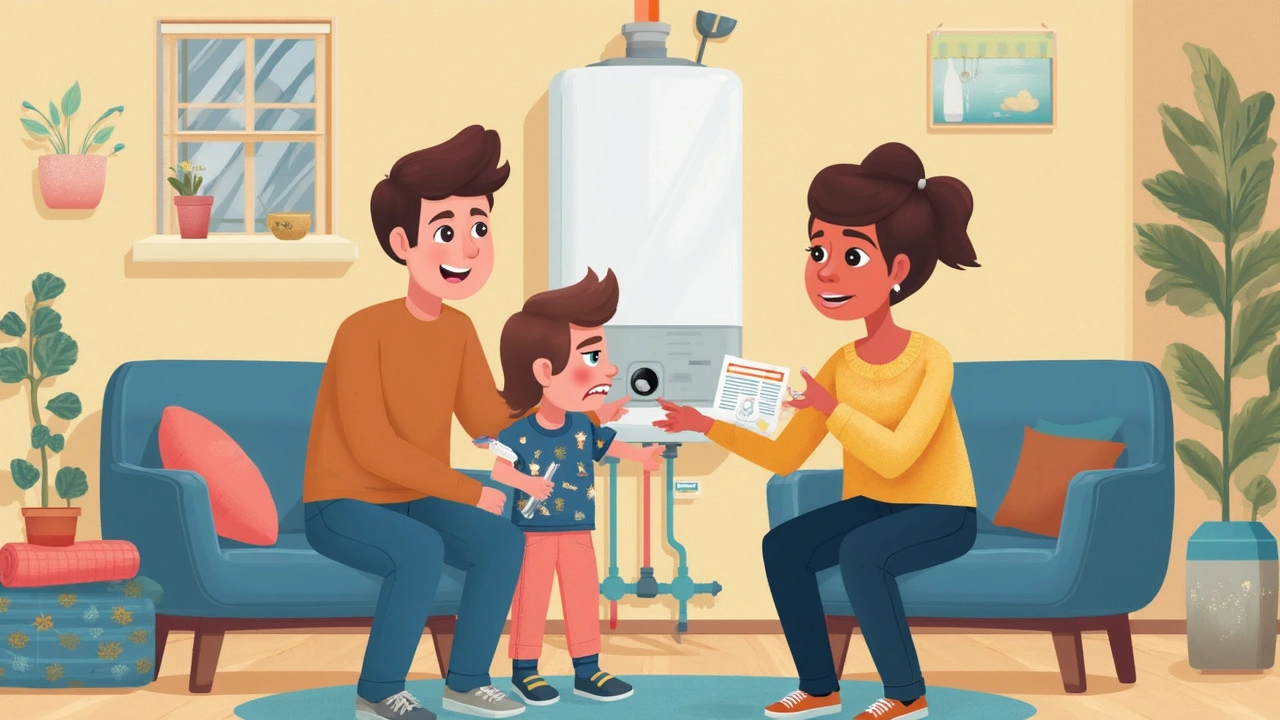Most people ignore their water heater until it's cold shower time—and that's a mistake. Dirt and minerals build up inside the tank, parts get worn, and if you don't stay on top of it, you could be facing a massive bill or an icy wake-up call one morning.
You don't have to be a pro to handle the basics. Think less about complicated plumbing, more about simple habits: draining a bit of water once in a while, listening for weird noises, and checking for leaks before they become disasters. Even small things make a big difference when it comes to keeping that hot water rolling.
If your heater is making banging or gurgling sounds, that’s usually not a good sign—it means minerals are caking up inside. Regular maintenance wipes out stuff like this before it starts wrecking things. Trust me, a half hour a couple times a year can save you some ugly repair costs down the road.
- The Basics Every Owner Should Know
- What Needs Checking (and How Often)
- Easy DIY Upkeep Steps
- When It’s Time to Call a Pro
The Basics Every Owner Should Know
Your water heater isn’t something you can just forget about after installation. Whether you’ve got a big tank in the basement or a small tankless unit hung on the wall, each one needs some basic care to avoid headaches. The number one thing is safety—hot water systems deal with heat, pressure, and sometimes even gas or electricity. Regular checks can actually stop bigger problems before they get out of control.
The water heater maintenance routine starts with understanding your heater type. Tank models hold and heat a set amount of water all day. If you see a big metal drum, that’s a tank type. On-demand or tankless versions heat water only when you need it, so they look more like a small box. Both kinds need regular attention but in slightly different ways.
Let’s talk expected lifespans. Tanks usually last about 8-12 years if you take care of them, while tankless models can push past 20 years. But here’s the deal—skipping maintenance can cut those numbers in half. Hard water is a common killer because the minerals build up fast inside the tank and on heating elements. That’s why flushing is so important, especially in spots with hard water.
| Type | Expected Lifespan (with maintenance) | Common Problems |
|---|---|---|
| Tank | 8-12 years | Sediment build-up, rust, leaks |
| Tankless | 15-20+ years | Scaling, ignition failures, clogs |
Every water heater has a thermostat—usually set at 120°F for safety and efficiency. Setting it higher is tempting, but it chews through energy and increases the risk of scalding. Modern units usually have a temperature-pressure relief valve (T&P valve). If too much pressure builds up, this valve opens to release it—but only if it isn’t stuck shut. Testing this valve once a year is a must.
Most people don’t realize that an anode rod inside tank heaters actually attracts minerals to fight rust. Over time, the rod erodes and needs replacement, or the tank will start to corrode. On tankless models, flushing helps prevent scale from choking out the system. No matter the type, keeping the area around the heater clean and checking for leaks every month is a smart move. Caught early, most issues are simple to fix.
What Needs Checking (and How Often)
There are a few parts of your water heater you just can't ignore if you want it to last. Each one needs a look at certain times—waiting too long usually means more trouble than it’s worth. Here’s what needs routine attention:
- Water heater maintenance starts with draining a couple gallons from the tank twice a year. This helps clear out all the gunk and minerals that settle at the bottom. Left alone, this stuff makes the heater work harder and wear out sooner.
- Check the pressure relief valve every 6 months. This small part keeps your tank from turning into a pressure cooker. Just lift the valve’s lever and make sure some water drains out the pipe. No water or leaks? It’s time to replace it.
- Peek in at the anode rod once a year. The rod attracts rust and stops your tank from corroding. If it looks thin or eaten away, get a new one without waiting for problems.
- Look for leaks, rust, or puddles under the heater at least once a month. These are early warning signs something bad is brewing inside.
- And don't forget to listen—popping or rumbling noises mean there’s a sediment party going on in the tank. More reason for that regular flush.
It helps to keep track with a calendar or set reminders in your phone. Regular checks beat emergencies every time. Here’s a quick guide to how often you should check the key stuff:
| What to Check | How Often |
|---|---|
| Drain 2-3 gallons from tank | Every 6 months |
| Test pressure relief valve | Every 6 months |
| Inspect anode rod | Once a year |
| Scan for leaks/rust under tank | Once a month |
| Listen for popping/rumbling sounds | Each time you’re near it |
The big thing here: don’t guess or hope your heater is doing fine. A couple of fast, scheduled checks each year can easily double its lifespan and avoid those ice-cold surprises.

Easy DIY Upkeep Steps
Don’t let your hot water heater become a ticking time bomb in your basement. Most folks can handle these tasks with a couple of basic tools and a bit of know-how. The main thing is to stay ahead of problems before they start. Here’s what you can do, plain and simple.
- Water heater maintenance means draining the tank once a year. Sediment settles at the bottom and messes with heating efficiency. Want it hotter, longer, for less? Attach a garden hose to the drain valve, open it up, and let water run out until it’s clear—not cloudy. Turn off power or gas first; nobody wants a scalding mess.
- Check the pressure relief valve. This valve is your heater’s emergency backup—pull up the lever a bit to make sure water comes out. No water or a stuck valve? It’s time for a replacement. Skipping this step is risky because if pressure builds up…let’s just say it’s not pretty.
- Scan for leaks around fittings and underneath. Quick wipe with your hand does the trick. Even a tiny drip can lead to serious water damage or rust. If you spot wetness, try tightening connections gently with a wrench—too much and you could crack something.
- Peek at the anode rod every 2-3 years. This thing attracts corrosion so your tank doesn’t rust through. You’ll need a socket wrench to unscrew it from the top. If it’s thin, crusty, or missing chunks, swap it out. Replacements cost way less than a new heater.
- Keep the thermostat at 120°F. That sweet spot keeps your energy bill down and prevents burns. Anything higher is just a waste, and bacteria doesn’t survive at that temp.
Let’s put it all in perspective—here’s a breakdown of what routine upkeep can really do for you:
| Task | How Often | Average Cost Saved |
|---|---|---|
| Flush Tank | Yearly | $50-$150 on energy bills |
| Check Anode Rod | Every 2-3 years | Can add 3-5 years to heater life |
| Test Pressure Valve | Yearly | Avoids $1K+ flood fixes |
These jobs won’t eat your whole weekend, but they’ll save you from emergency plumber calls and ice-cold showers. If something looks off, don’t wait. Tackle it now, and your water heater will stick around way longer.
When It’s Time to Call a Pro
Not every water heater issue is something you can or should fix yourself. There are moments when calling a licensed plumber is the smartest move, both for your safety and your wallet. Ignoring warning signs can turn a fixable problem into a total headache and sometimes even property damage.
Here’s when you absolutely want to skip the DIY and let an expert handle it:
- Water heater maintenance revealed serious leaks coming from the tank itself—if the tank is rusted through or constantly dripping, replacement is usually the only answer.
- Hot water comes out rusty or has a bad smell, even after flushing—this can point to a corroded anode rod, decaying tank lining, or even bacteria growth.
- Your pilot light (on gas heaters) won’t stay lit or you notice the burner acts weird. Repeated lighting issues can be a sign of ventilation or gas problems—not something to play with.
- You hear popping, rumbling, or hissing every time the heater cycles on, even after draining and flushing.
- No hot water at all, or temperature swings that don’t get better with a thermostat check.
- You spot electrical issues, like a breaker tripping or burnt wiring near an electric model.
Here’s a quick look at what often triggers a pro visit, and how urgent it really is:
| Problem | DIY? | Get a Pro? | Wait? |
|---|---|---|---|
| Tank leaking | No | Absolutely | No |
| Rusty/bad-smelling water | Try flushing first | Yes, if it persists | No |
| Pilot won’t stay lit | No | Yes | No |
| Loud noises | Try flushing | Yes, if it continues | Soon |
| No hot water | Check breaker/thermostat | Yes, if unsolved | No |
| Electrical issues | No | Immediately | No |
One more thing—did you know the average lifespan of a standard water heater is about 8 to 12 years? If yours is getting close and starting to act up, don’t keep throwing money at repairs. At some point, replacement is the safer (and sometimes cheaper) choice.
So if your gut says “this is above my pay grade,” or you’re worried about your family’s safety, those are real red flags. There’s no shame in letting the pros do their job. You’ll end up saving time, money, and a lot of headaches.

